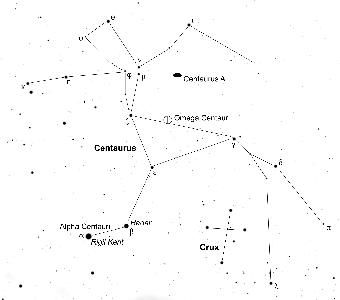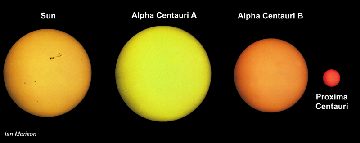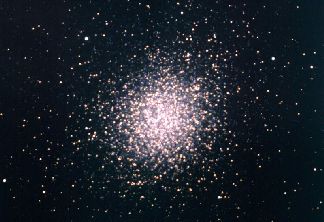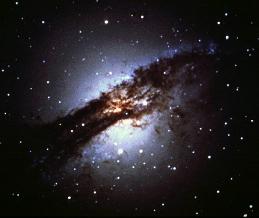Centaurus
- Alpha Centauri - Multiple Star System
- Omega Centauri - Globular Cluster
- Centaurus A - Peculiar Galaxy
Though not as well known as Crux, the Southern Cross, there is no doubt that Centaurus is the most impressive southern constellation of all. The ninth largest constellation in the sky, over 100 of its stars are visible to the unaided eye. Centaurus lies too far south to contain any Messier objects. It does, however, contain three A-List objects: one of these, Alpha Centauri, is the nearest star system to our Sun, another the best globular cluster in the heavens and the third a dynamic galaxy. Best observed in the autumn when it comes almost overhead.
Alpha Centauri Multiple Star System E H
Its name is often shortened to Rigel Kent and, to the eye, looks like a single star of magnitude -0.3, the third brightest star in the sky. It lies at a distance of 4.35 light years. With a telescope it splits easily into two stars: the primary A is a G-type star very similar to our Sun which has an apparent magnitude of -0.04 whilst the secondary B is an orange K-type star of magnitude 1.2. They circle each other in a highly elliptical orbit with a period of 80 years having a mean separation of 24 AU - about the distance of Uranus from the Sun. They currently appear separated by 19 arc seconds and are thus easily split with a small telescope. There is a third member of the star system Alpha Centauri C that is 13,000 AU from A and B. As it is measurably closer to us, at a distance of 4.22 light years, it is also called Proxima Centauri and is the nearest star to our solar system.
Position: 14h 39.6m -60deg 50min
Omega Centauri Globula Cluster E M
This is the most spectacular globular cluster in the heavens, appearing as a 4th magnitude "fuzzy" star to the unaided eye. Moving north of Hadar, Beta (?) Centauri, by 5 and 10 degrees, ~ two finder fields in total, are two 2nd magnitude stars Eta, the more southerly, and Zeta Centauri. Omega Centauri makes an almost equilateral triangle with these two stars on their western side. With an equatorially mounted telescope one can centre Zeta Centauri in a medium power telescope field, lock the declination axis and then sweep 28 minute west. This should bring Omega Centauri into the field of view. It contains perhaps 10 million stars in a region about 160 light years across. It lies at a distance of some 17,000 light years and has an apparent diameter of 30 arc minutes or more - the size of the full moon! It does not have a very bright central core of light as is found in 47 Tucanae. Omega Centauri is a wonderful sight in a telescope of 8 inches( 200mm) or more, but still very rewarding even with a 4 inch (100mm) aperture if the sky is dark and transparent. With a mass of about 5 million solar masses it is 10 times more massive than the Milky Way's other large globulars such as M13 in Hercules and has a similar mass to some small galaxies! It is the most luminous globular cluster in our Milky Way and is only outshone by the cluster G1 in the Andromeda Nebula in our local group of galaxies.
Position:13h 26.8m -47deg 29min
Centaurus A Peculiar Galaxy M
Centaurus A, so called as it is a very bright radio source, is a large bright (7th magnitude) elliptical galaxy crossed by a very prominent dust lane. It is often rightly called "peculiar" galaxy and is one of the most interesting galaxies that we can observe. One possible scenario is that it may have "eaten" a large spiral galaxy in the last few billion years. The distance to C77 is not well known lying in the range 10-16 million light years. It forms a right-angled triangle with Zeta Centauri and C80 Omega Centauri (see instructions for finding both in the C80 description above). With an equatorial telescope find three third magnitude stars, mu nu and psi Centauri, forming part of a tight triangle five degrees north of Zeta Centauri and a little west. Image mu in a wide field, lock the declination axis and move westwards 24 minutes in right ascension to bring C77 into the field of view. The galaxy subtends an area 17 by 13 arc minutes in size. With a small telescope and dark skies, both halves of the galaxy are visible with the dark dust lane about 40 arc seconds in width running across the middle. Larger telescopes and higher power will show two foreground stars superimposed on the southern half, the brighter being 12th and the fainter 13.5 magnitude. Centaurus A is one of the largest, most massive and luminous galaxies known. It harbours an "active galactic nucleus" in which material is falling in towards a supermassive black hole - perhaps weighing 100 million times that of our Sun! Opposing jets of particles have left the active nucleus and radiation from them produces two vast lobes of radio emission above and below. These make Centaurus A one of the strongest radio sources in the sky.
Position: 13h 25.5m -43deg 01min







